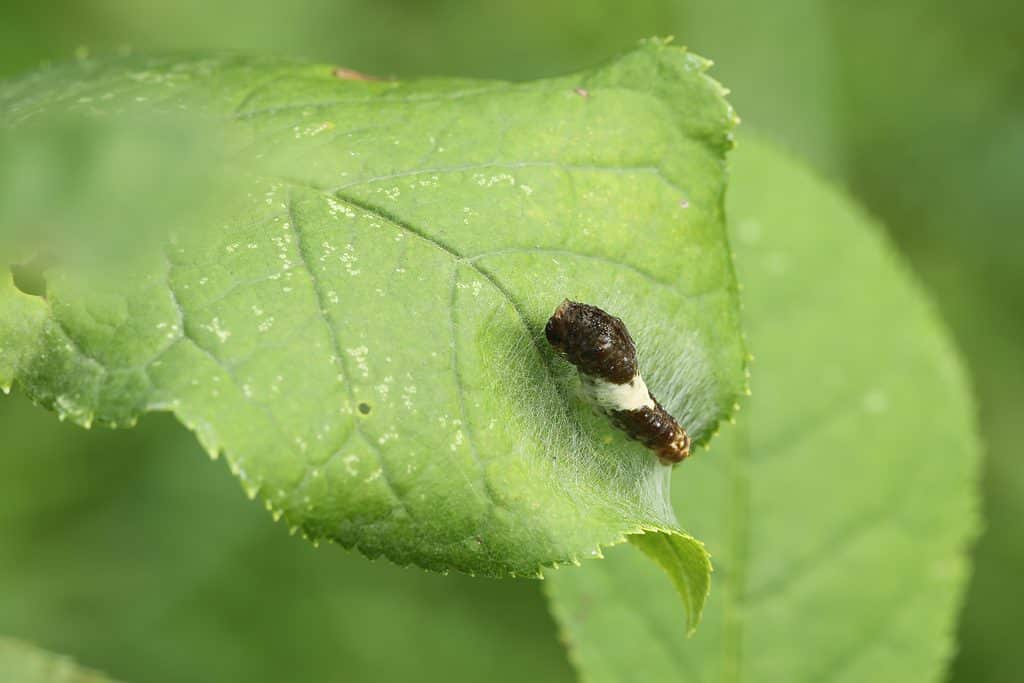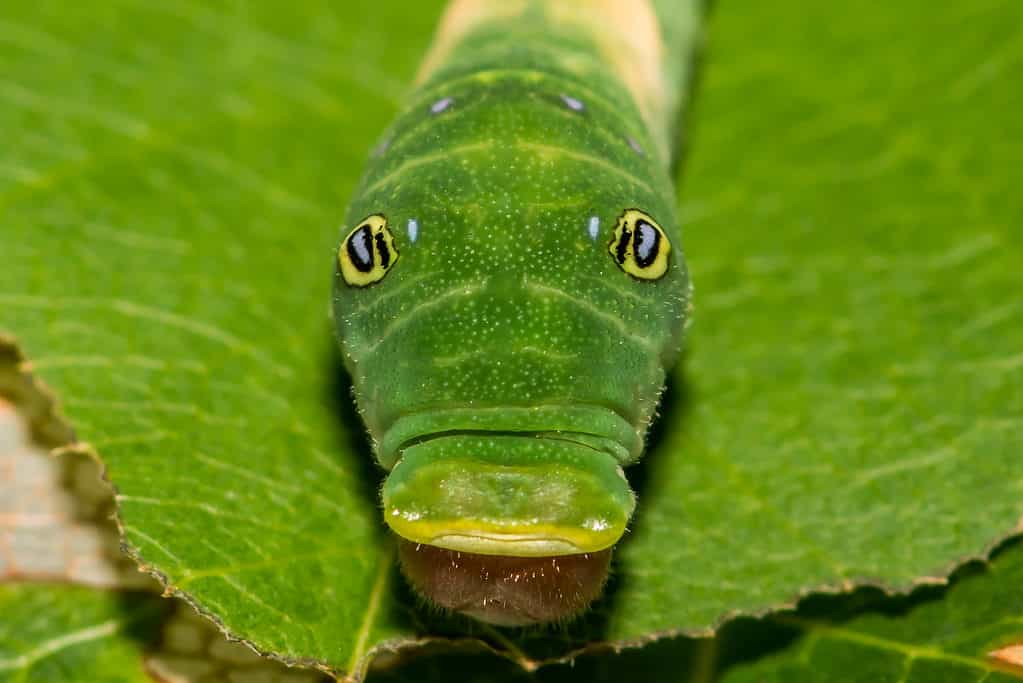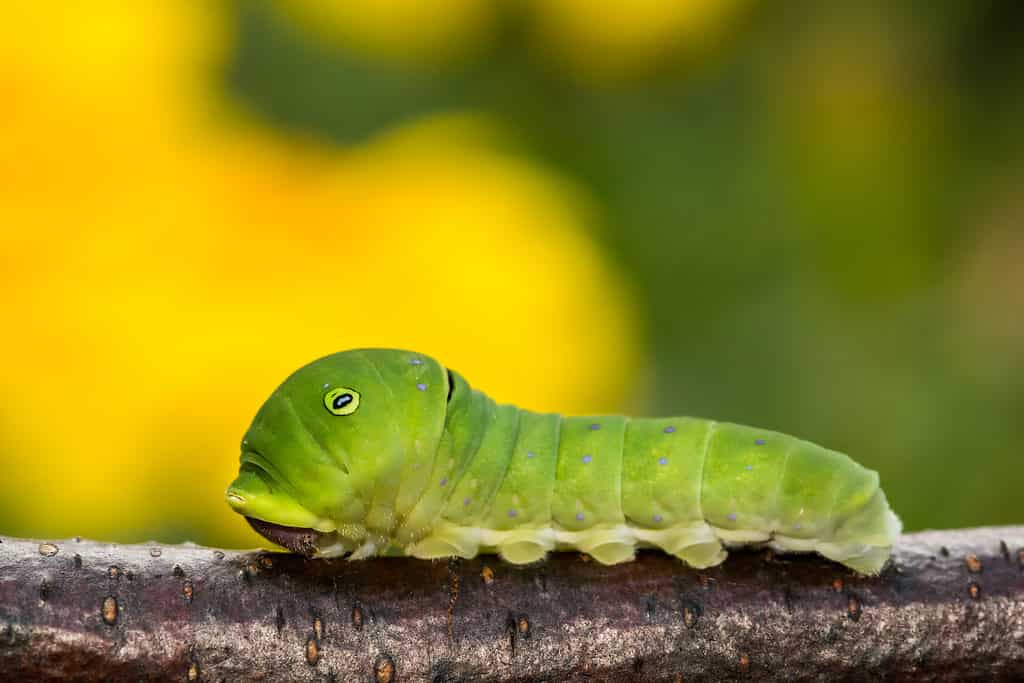Tiger Swallowtail Caterpillar
Papilio glaucus
Immature tiger swallowtail caterpillars resemble bird droppings. This is to throw would-be predators off.
Advertisement
Tiger Swallowtail Caterpillar Scientific Classification
- Kingdom
- Animalia
- Phylum
- Arthropoda
- Class
- Insecta
- Order
- Lepidoptera
- Family
- Papilionidae
- Genus
- Papilio
- Scientific Name
- Papilio glaucus
Read our Complete Guide to Classification of Animals.
Tiger Swallowtail Caterpillar Conservation Status

Tiger Swallowtail Caterpillar Facts
- Prey
- Plant leaves
- Main Prey
- Tulip poplar
- Name Of Young
- N/A
- Group Behavior
- Solitary
- Fun Fact
- Immature tiger swallowtail caterpillars resemble bird droppings. This is to throw would-be predators off.
- Estimated Population Size
- undetermined
- Biggest Threat
- habitat loss
- Most Distinctive Feature
- false eyes, or eyespots, which appear to be the eyes of a much larger animal, deterring would-be predators.
- Distinctive Feature
- Tiger swallowtail caterpillars have a pair of osmeterium (osmeteria, plural), scent glands that produce a nasty smelling compound to ward off predators.
- Other Name(s)
- Estern tiger swallowtail caterpillar
- Gestation Period
- about 1 week
- Temperament
- docile
- Wingspan
- N/A
- Training
- N/A
- Optimum pH Level
- N/A
- Incubation Period
- N/A
- Age Of Independence
- birth
- Age Of Fledgling
- N/A
- Average Spawn Size
- N/A
- Litter Size
- N/A
- Habitat
- Tigerger swallowtail caterpillars live in woodlands, along streams and rivers, in swamps and wetlands, and suburban and urban areas. They are native to eastern North America, from Southern Canada to Northern Mexico, and west to the Great Plains.
- Predators
- The tiger swallowtail's predators include birds, spiders, wasps, and small mammals. Some specific examples are birds such as Eastern phoebes, Baltimore orioles, and yellow warblers; spiders like wolf spiders and yellow garden spiders; parasitic wasps, like braconid wasps and Ichneumon wasps; and small mammals like chipmunks and shrews.
- Diet
- Herbivore
- Average Litter Size
- N/A
- Lifestyle
- Nocturnal
- Favorite Food
- Tulip poplar
- Type
- Papilio glaucus
- Common Name
- Tiger swallowtail
- Special Features
- Tiger swallowtail caterpillars have a pair of osmeterium (osmeteria, plural), scent glands that produce a nasty smelling compound to ward off predators.
- Origin
- North America
- Location
- North America
- Slogan
- N/A
- Group
- Kaleidoscope
- Nesting Location
- under leaves
- Age of Molting
- the tiger swallowtail will molt 5 times throughout its lifetime.
Tiger Swallowtail Caterpillar Physical Characteristics
- Color
- Brown
- Black
- White
- Green
- Skin Type
- Exoskeleton
- Lifespan
- 1-7 weeks
- Weight
- less than one ounce.
- Height
- 0.25 - 0.5 inches
- Length
- 1 - 2 inches
- Age of Sexual Maturity
- N/A
- Age of Weaning
- N/A
- Venomous
- No
- Aggression
- Low
View all of the Tiger Swallowtail Caterpillar images!
The tiger swallowtail caterpillar (Papilio glaucus), is the larval stage of the tiger swallowtail butterfly, which is native to North America. Though there are four separate species of tiger swallowtails of this article, our focus will be the Eastern tiger swallowtail. The caterpillar is typically green with two large eyespots on either side of its head. They can grow up to 2 inches in length. Their diet consists of the leaves of trees and shrubs such as tulip poplar, sweet bay, and wild cherry. After munching on leaves for a few weeks, the caterpillars spin a chrysalis, pupate, and transform into butterflies. Keep reading to learn more about tiger swallowtail caterpillars!
Five Fun Facts About Tiger Swallowtail Caterpillars
- Tiger swallowtail caterpillars have a unique defense mechanism. They will drop from the leaves they are eating and dangle on silk threads when they sense danger, this will make them hard for a predator to spot.
- Eastern tiger swallowtail caterpillars are voracious eaters and can consume entire leaves on their host plants.
- Immature caterpillars resemble bird droppings. This is to throw would-be predators off.
- Mature Eastern tiger swallowtail caterpillars are green with yellow/white/black false eyes. These large round spots look like the eyes of larger animals, deterring would-be predators.
- They have osmeteria, horn-like protuberances that secrete an abhorrent scent when there are threatened or sense danger.

Immature caterpillars resemble bird droppings.
©Kevin Collison/Shutterstock.com
Tiger Swallowtail Caterpillar: Scientific Name
The scientific name for the Eastern tiger swallowtail caterpillar is Papilio glaucus. It shares its name with its adult form, the tiger swallowtail butterfly. Papilio is the Latin word for butterfly. Glaucus means gray in Latin. Hence, their name translates to gray butterfly. Perhaps a more fitting moniker for these whimsical creatures would be Bruchus viridi: green caterpillar! The earliest reference to the name tiger swallowtail appears in the book The Butterflies of the Eastern United States and Canada by Samuel Hubbard Scudder, published in 1889.
Appearance and Behavior
Appearance
The Eastern tiger swallowtail caterpillar is brown and white as a hatchling. In its immature form, it is said to resemble bird droppings. This is an evolutionary adaptation that has allowed the species to survive. Though predators such as birds, lizards, and snakes might be interested in consuming the tasty morsel that a hatchling caterpillar could provide, these would-be predators are not remotely interested in eating bird poop. In its mature form, the caterpillar is green, with two false eyes, or eyespots, on either side of its head. The false eyes appear to predators to belong to a much larger creature, thus deterring them from attacking the caterpillars.

Photo of a mid-stage tiger swallowtail caterpillar, that hasn’t yet turned green.
©Gerry Bishop/Shutterstock.com
The tiger swallowtail has a smooth, cylindrical body shape and can grow up to 2 inches in length. Like the insects that they are, their bodies consist of three regions: the head, the thorax, and the abdomen. The head contains the eyes, antennae, and mouthparts. Thoraxes consist of three segments: the prothorax, mesothorax, and metathorax. The thorax is responsible for movement. Each of the segments of the thorax bears one pair of legs, three pairs, or six legs in total. The abdomen contains the caterpillar’s organs and is responsible for respiration, digestion, excretion, and reproduction.

In its mature form, the tiger swallowtail caterpillar is green, with two false eyes, or eyespots, on either side of its head.
©Jay Ondreicka/Shutterstock.com
Behavior
The tiger swallowtail caterpillar’s life is a solitary one. They spend the majority of their lives feeding, molting, and growing. Tiger swallowtail caterpillars go through five instars during their larval stage. An Instar is a developmental stage of an insect between molts. During each instar, the insect grows and develops until it is ready to molt to the next stage. The number of instars an insect goes through can vary, but most insects go through several instars before reaching adulthood. In the case of the tiger swallowtail caterpillar, it goes through five instar stages before it reaches the pupal stage. Experts can determine which instar a caterpillar is in by the caterpillar’s appearance and behavior.

The tiger swallowtail has a smooth, cylindrical body shape and can grow up to 2 inches in length.
©Jay Ondreicka/Shutterstock.com
Tiger swallowtail caterpillars are voracious eaters, consuming entire leaves of host plants, one tiny bite at a time. These caterpillars are not considered to be particularly destructive to their host plants. While they do consume leaves, they typically do not cause significant damage to the plant. However, in large numbers, they may defoliate a small tree or shrub.
Young caterpillars will drop from the leaves they are eating and dangle on silk threads when they sense danger, which makes them hard for a predator to spot. These caterpillarshave specialized scent glands, osmeteria, that emerge from the back of their heads when they sense danger. These scent glands release a most unpleasant scent which is offputting to would-be predators.
Tiger Swallowtail Caterpillar: Evolution and History
Origin and History
The Tiger Swallowtail lives throughout North America, including Southern Canada, Northern Mexico, and the United States. Though the Eastern tiger swallowtail, is perhaps the original tiger swallowtail, it has recently been determined that there are four separate subspecies of tiger swallowtails:
- Appalachian tiger swallowtail
- Canadian tiger swallowtail
- Eastern tiger swallowtail
- Western tiger swallowtail
Interestingly, the Appalachian subspecies is thought to be a hybrid of the Canadian and Eastern tiger swallowtails. Hybridization in animals is quite rare.
Evolution
The Eastern tiger swallowtail caterpillar has undergone a couple of evolutionary adaptions to assist and ensure its survival. As mentioned earlier, immature tiger swallowtail caterpillars look like bird droppings. This is by design, as would-be predators, some of them birds(!) are not interested in bird droppings. These crafty caterpillars will drop from leaves, suspended in the air by a silklike thread. This adaptive behavior makes it more difficult for predators to locate and attack the caterpillars. They also have acquired osmeteria (osmeterium, singularly), scent glands that excrete a foul-smelling compound, thought to be pheromones, which discourage would-be predators.
Tiger swallow
Tiger Swallowtail Caterpillars: Habitat and Diet
Eastern tiger swallowtail caterpillars’ habitat consists of trees such as tulip poplar, sweet bay, and wild cherry. Tiger swallowtails live in woodlands, along streams and rivers, in swamps and wetlands, and suburban and urban areas. They are native to eastern North America, from southern Canada to Florida, and west to the Great Plains. Tiger swallowtail caterpillars have adapted to changing habitats by developing a wide range of food preferences. They feed on an array of host plants, including cherry, ash, tulip poplar, and wild black cherry trees. Tiger swallowtails will feed on non-native plant species such as the introduced purple loosestrife and Japanese knotweed. This dietary flexibility allows them to thrive in a wide range of habitats, including both natural and human-altered environments.
Tiger Swallowtail Caterpillars: Predators and Threats
Eastern tiger swallowtail caterpillars have a variety of predators, including birds, spiders, wasps, and small mammals. Some specific examples are birds such as Eastern phoebes, Baltimore orioles, and yellow warblers; spiders like wolf spiders and yellow garden spiders; parasitic wasps, like braconid wasps and Ichneumon wasps; and small mammals like chipmunks and shrews. However, predators are the least of these creatures’ worries.
Habitat loss and fragmentation, climate change, pesticides, and herbicides pose a larger threat to tiger swallowtail caterpillars’ existence than predation. The destruction of forests and other natural habitats through logging, urbanization, and agriculture reduces the availability of suitable habitats for Eastern Tiger Swallowtail caterpillars. Rising temperatures and shifting weather patterns can disrupt the timing of seasonal events, such as when plants bloom and when caterpillars hatch, making it more difficult for Eastern Tiger Swallowtail caterpillars to find food and survive to adulthood. Herbicides kill the native plants that Eastern Tiger Swallowtail caterpillars rely on for food, while pesticides directly kill the caterpillars themselves. Non-native plants are invasive, competing with native plants, resulting in a reduction of native food sources. However, as noted above, tiger swallowtail caterpillars have adapted to and will eat certain non-native plants.
Tiger Swallowtail Caterpillars: Lifecycle
The Eastern Tiger Swallowtail caterpillar goes through four stages of development: egg, larva (caterpillar), pupa (chrysalis), and adult (butterfly).
In the first stage, the female Eastern tiger swallowtail butterfly lays her eggs on the leaves of a host plant, such as cherry, tulip poplar, or sweet bay. The eggs are small and yellow, and they hatch in about a week. Once the eggs hatch, the caterpillars begin to feed on the leaves of the host plant. They go through five instars (growth stages) before reaching full size. The hatchlings look like bird dropping in their earliest stage, before growing and turning green. They have a pair of false eyespots on the thorax. After the caterpillar’s fifth instar, or molt, they stop eating and begin to look for a place to form a chrysalis. They will spin a silk pad and attach themselves to a twig or other surface with a silk girdle. The chrysalis is green with gold spots, and it will remain in this stage for about two weeks. Once the chrysalis has hardened, and the pupa has metamorphosed, the butterfly will emerge. The butterfly will live for about a month, during which time it will mate and lay eggs to begin the cycle again.
Conservation Status and Population
Conservation status of the Eastern tiger swallowtail caterpillar is undetermined, as conservation status is conferred upon the adult form of an animal. Eastern tiger swallowtail butterflies, the adult form of these caterpillars is considered species of least concern under the Endangered Species Act. However, as with many species, their populations can be affected by habitat loss and other human activities. Caterpillar and butterfly populations are difficult to accurately gauge, so while the tiger swallowtail caterpillar is not in danger of extinction, there are no specific numbers related to its population size.
Up Next:
View all 133 animals that start with TTiger Swallowtail Caterpillar FAQs (Frequently Asked Questions)
hat does an immature tier swallowtail caterpillar look like?
In its immature form, the tiger swallowtail butterfly is brown and white and resembles bird droppings. this is an evolutionary adaption to resist predators.
How many separate species of tiger swallowtails are there?
It has recently been determined that there are four separate subspecies of tiger swallowtails:
- Appalachian tiger swallowtail
- Canadian tiger swallowtail
- Eastern tiger swallowtail
- Western tiger swallowtail
Interestingly, the Appalachian tiger swallowtail is thought to be a hybrid of the Canadian and Eastern tiger swallowtails. Hybridization in animals is quite rare.
of what does the tiger swallowtail's diet consist?
Tiger swallowtail caterpillars feed on an array of host plants, including cherry, ash, tulip poplar, and wild black cherry trees. Tiger swallowtails will feed on non-native plant species such as the purple loosestrife and Japanese knotweed. This dietary flexibility allows them to thrive in a wide range of habitats, including both natural and human-altered environments.
Are tiger swallowtail caterpillars considered an endangered species?
The conservation status of the Eastern tiger swallowtail caterpillar is undetermined, as conservation status is conferred upon the adult form of an animal. Eastern tiger swallowtail butterflies, the adult form of these caterpillars are considered a species of least concern under the Endangered Species Act. However, as with many species, their populations can be affected by habitat loss and other human activities.
What are some of the threats that tiger swallowtail caterpillars face?
Some of the threats that tiger swallowtail caterpillars face include habitat loss and fragmentation, climate change, pesticides, and herbicides. These pose a larger threat to tiger swallowtail caterpillars’ existence than predation.
Thank you for reading! Have some feedback for us? Contact the AZ Animals editorial team.
Sources
- nhpbs.org, Available here: https://nhpbs.org/natureworks/easterntiger.htm
- inaturalist.org, Available here: https://www.inaturalist.org/guide_taxa/357989
- wikipedia.org, Available here: https://en.wikipedia.org/wiki/Papilio_glaucus
















